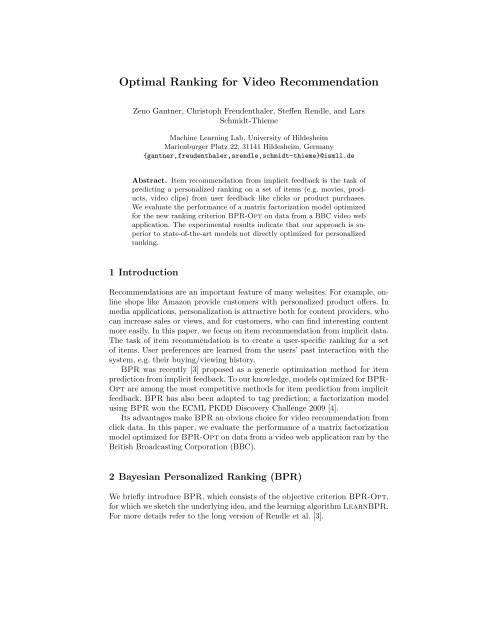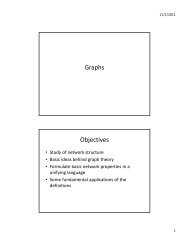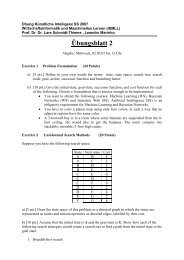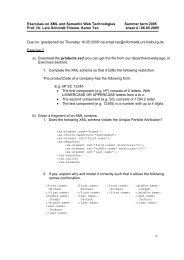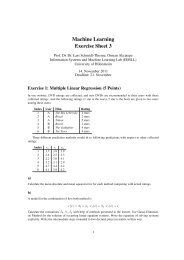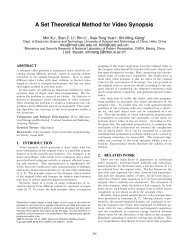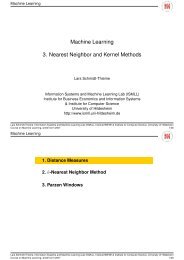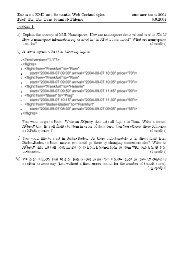Optimal Ranking for Video Recommendation - ISMLL
Optimal Ranking for Video Recommendation - ISMLL
Optimal Ranking for Video Recommendation - ISMLL
Create successful ePaper yourself
Turn your PDF publications into a flip-book with our unique Google optimized e-Paper software.
<strong>Optimal</strong> <strong>Ranking</strong> <strong>for</strong> <strong>Video</strong> <strong>Recommendation</strong><br />
Zeno Gantner, Christoph Freudenthaler, Steffen Rendle, and Lars<br />
Schmidt-Thieme<br />
Machine Learning Lab, University of Hildesheim<br />
Marienburger Platz 22, 31141 Hildesheim, Germany<br />
{gantner,freudenthaler,srendle,schmidt-thieme}@ismll.de<br />
Abstract. Item recommendation from implicit feedback is the task of<br />
predicting a personalized ranking on a set of items (e.g. movies, products,<br />
video clips) from user feedback like clicks or product purchases.<br />
We evaluate the per<strong>for</strong>mance of a matrix factorization model optimized<br />
<strong>for</strong> the new ranking criterion BPR-Opt on data from a BBC video web<br />
application. The experimental results indicate that our approach is superior<br />
to state-of-the-art models not directly optimized <strong>for</strong> personalized<br />
ranking.<br />
1 Introduction<br />
<strong>Recommendation</strong>s are an important feature of many websites. For example, online<br />
shops like Amazon provide customers with personalized product offers. In<br />
media applications, personalization is attractive both <strong>for</strong> content providers, who<br />
can increase sales or views, and <strong>for</strong> customers, who can find interesting content<br />
more easily. In this paper, we focus on item recommendation from implicit data.<br />
The task of item recommendation is to create a user-specific ranking <strong>for</strong> a set<br />
of items. User preferences are learned from the users’ past interaction with the<br />
system, e.g. their buying/viewing history.<br />
BPR was recently [3] proposed as a generic optimization method <strong>for</strong> item<br />
prediction from implicit feedback. To our knowledge, models optimized <strong>for</strong> BPR-<br />
Opt are among the most competitive methods <strong>for</strong> item prediction from implicit<br />
feedback. BPR has also been adapted to tag prediction; a factorization model<br />
using BPR won the ECML PKDD Discovery Challenge 2009 [4].<br />
Its advantages make BPR an obvious choice <strong>for</strong> video recommendation from<br />
click data. In this paper, we evaluate the per<strong>for</strong>mance of a matrix factorization<br />
model optimized <strong>for</strong> BPR-Opt on data from a video web application ran by the<br />
British Broadcasting Corporation (BBC).<br />
2 Bayesian Personalized <strong>Ranking</strong> (BPR)<br />
We briefly introduce BPR, which consists of the objective criterion BPR-Opt,<br />
<strong>for</strong> which we sketch the underlying idea, and the learning algorithm LearnBPR.<br />
For more details refer to the long version of Rendle et al. [3].
2 Zeno Gantner et al.<br />
2.1 Motivation <strong>for</strong> BPR-Opt<br />
Implicit feedback often consists only of positive observations. The non-observed<br />
user-item pairs – e.g. a user has not viewed a video – are a mix of real negative<br />
feedback (not interested in viewing it at all) and missing values (may want to<br />
view in the future).<br />
Let U be the set of all users and I the set of all items. The known implicit<br />
feedback be S ⊆ U × I. The task is now to provide a personalized total ranking<br />
> u ⊂ I 2 <strong>for</strong> each user.<br />
i 1<br />
i 2<br />
i 3<br />
i 4<br />
j 1 + + ?<br />
u 4 ? ? + +<br />
u 4 0 0 1 1<br />
u 4 ? ? + +<br />
u<br />
u 5 ? ? + ?<br />
u 5 0 0 1 0<br />
u ? ? + ?<br />
5<br />
: i > u5<br />
j<br />
5<br />
i 1<br />
i 2<br />
i 3<br />
i 4<br />
item<br />
item<br />
item<br />
j 1 ? + ?<br />
j 2 ? <br />
i 1<br />
i 2<br />
i 3<br />
i 4<br />
i 1<br />
i 2<br />
i 3<br />
i 4<br />
i 1<br />
i 2<br />
i 3<br />
i<br />
j 3 ? <br />
4<br />
u 1 ? + + ?<br />
u 1 0 1 1 0<br />
u j<br />
1 ? + + ?<br />
4<br />
? + +<br />
u 2 + ? ? +<br />
u 2 1 0 0 1<br />
u 2 + ? ? +<br />
item<br />
u 3 + + ? ?<br />
u 3 1 1 0 0<br />
u 3 + + ? ?<br />
...<br />
j 2 ? + ?<br />
j 3 <br />
? ? +<br />
user<br />
user<br />
user<br />
j 4<br />
u 1<br />
: i > u1<br />
j<br />
Fig. 1. Left: Usually, negative data is generated by filling the matrix with 0 values.<br />
Right: BPR creates user-specific preferences i > u j between item pairs. On the right<br />
side, + means a user prefers item i over item j; − means they prefer j over i.<br />
Item recommenders [1, 2] typically create the training data from S by giving<br />
pairs (u, i) ∈ S a positive class label and all other combinations a negative<br />
one (see Fig. 1). Then a model is fitted to this data, which means is optimized<br />
to predict the value 1 <strong>for</strong> elements in S and 0 <strong>for</strong> the rest. The problem of this<br />
approach is that all elements to be ranked in the future are presented as negative<br />
examples to the learning algorithm.<br />
We propose a different approach by using item pairs as training data and<br />
optimize <strong>for</strong> correctly ranked item pairs instead of scoring single items. This<br />
represents the problem better than just replacing missing values with negative<br />
ones. From S we try to reconstruct > u <strong>for</strong> each user. If an item has been viewed<br />
by a user, then we assume that the user prefers this item over all other nonobserved<br />
items. See Fig. 1 <strong>for</strong> an example. For items that have both been seen<br />
by a user, we cannot infer any preference. The same is true <strong>for</strong> two items that a<br />
user has not seen yet.<br />
D S := {(u, i, j)|i ∈ I + u ∧ j ∈ I \ I + u } ⊆ U × I × I<br />
The interpretation of (u, i, j) ∈ D S is that user u prefers i over j. Our approach<br />
has two advantages: (1) The training data D S consists of both positive and<br />
negative pairs and missing values. The missing values between two non-observed<br />
item<br />
item<br />
item
<strong>Optimal</strong> <strong>Ranking</strong> <strong>for</strong> <strong>Video</strong> <strong>Recommendation</strong> 3<br />
items are exactly the item pairs that have to be ranked in the future. (2) The<br />
training data is created <strong>for</strong> the actual objective of ranking, i.e. the observed<br />
subset D S of > u is used <strong>for</strong> training.<br />
2.2 Learning Algorithm and Application to Matrix Factorization<br />
To optimize <strong>for</strong> BPR-Opt, [3] we use LearnBPR, a stochastic gradient-descent<br />
algorithm (see Fig. 2). Using bootstrap sampling instead of full cycles through<br />
the data is especially useful as the number of examples is very large, and <strong>for</strong><br />
convergence often a fraction of a full cycle is sufficient.<br />
1: procedure LearnBPR(D S, Θ)<br />
2: initialize Θ<br />
3: repeat<br />
4: draw (u, i, j) from D S<br />
“<br />
5: Θ ← Θ + α<br />
6: until convergence<br />
7: return ˆΘ<br />
8: end procedure<br />
e −ˆx uij<br />
·<br />
1+e −ˆx uij<br />
”<br />
∂<br />
∂Θ ˆxuij − λΘ · Θ<br />
Fig. 2. Optimizing <strong>for</strong> BPR-Opt with bootstrapping-based gradient descent.<br />
Because we have triples (u, i, j) ∈ D S , we decompose the estimator ˆx uij :<br />
ˆx uij := ˆx ui − ˆx uj . Now we can apply any model that predicts ˆx ul , l ∈ I.<br />
Matrix factorization (MF) models are known to outper<strong>for</strong>m [5] many other<br />
models <strong>for</strong> the related task of rating prediction. They are also state-of-the-art<br />
<strong>for</strong> item prediction. MF approximates the target matrix X by the product of<br />
two low-rank matrices W : |U| × k and H : |I| × k by ˆX := W H t . For estimating<br />
whether a user prefers one item over another, we optimize the parameters Θ =<br />
(W, H) <strong>for</strong> the BPR-Opt criterion using our algorithm. To apply LearnBPR<br />
to MF, only the gradient of ˆx uij wrt. every model parameter has to be derived.<br />
3 Evaluation<br />
We compare learning the MF model with LearnBPR to weighted regularized<br />
matrix factorization (WR-MF) [1, 2]. We also report results <strong>for</strong> a baseline method<br />
that ranks the items by global frequency.<br />
The BBC data was collected from one of BBC’s online services during a ten<br />
day period in 2009. It contains 2,867,128 viewing events generated by 189,228<br />
anonymous users on 5,125 different video clips. For comparability, we report<br />
results on a subset of the Netflix data. 1<br />
We randomly removed one user-item pair per user to create the training set.<br />
and repeated all experiments 10 times by drawing train/test splits in each round.<br />
1 The results are taken from [3]. The subset contains 10, 000 users, 5000 items, and<br />
565, 738 rating actions, where each user and item have at least 10 ratings.
4 Zeno Gantner et al.<br />
Web <strong>Video</strong>: BBC<br />
<strong>Video</strong> Rental: Netflix<br />
AUC<br />
0.94 0.95 0.96 0.97 0.98 0.99<br />
most−popular<br />
Cosine−kNN<br />
WR−MF<br />
BPR−MF<br />
AUC<br />
0.80 0.82 0.84 0.86 0.88 0.90 0.92<br />
● ● ● ● ●<br />
●<br />
BPR−MF<br />
BPR−kNN<br />
WR−MF<br />
SVD−MF<br />
Cosine−kNN<br />
most popular<br />
np max<br />
10 20 30 40 50 60<br />
10 20 50 100<br />
number of dimensions<br />
number of dimensions<br />
Fig. 3. Area under the ROC curve (AUC) prediction quality <strong>for</strong> BBC and Netflix.<br />
You can see in Fig. 3 that on Netflix, BPR-MF outper<strong>for</strong>ms all other methods<br />
in prediction quality on both datasets.<br />
4 Conclusion and Future Work<br />
We evaluated the per<strong>for</strong>mance of a matrix factorization model optimized <strong>for</strong> the<br />
recently proposed generic criterion BPR-Opt on data from a BBC video web<br />
application. The results indicate that the method outper<strong>for</strong>ms other state-ofthe-art<br />
methods. This is justified by the theoretical analysis in [3]. In the future,<br />
we will conduct a large-scale study on additional real-world datasets from the<br />
MyMedia project field trials.<br />
Acknowledgements We thank the BBC <strong>for</strong> providing the video dataset, and<br />
Chris Newell <strong>for</strong> fruitful discussions. This work was co-funded by the EC FP7<br />
project MyMedia under the grant agreement no. 215006.<br />
References<br />
1. Y. Hu, Y. Koren, and C. Volinsky. Collaborative filtering <strong>for</strong> implicit feedback<br />
datasets. In ICDM 2008, 2008.<br />
2. R. Pan, Y. Zhou, B. Cao, N. N. Liu, R. M. Lukose, M. Scholz, and Q. Yang. Oneclass<br />
collaborative filtering. In ICDM 2008, 2008.<br />
3. S. Rendle, C. Freudenthaler, Z. Gantner, and L. Schmidt-Thieme. BPR: Bayesian<br />
personalized ranking from implicit feedback. In UAI 2009, 2009.<br />
4. S. Rendle and L. Schmidt-Thieme. Factor models <strong>for</strong> tag recommendation in bibsonomy.<br />
In Discovery Challenge at ECML PKDD 2009, 2009.<br />
5. J. D. M. Rennie and N. Srebro. Fast maximum margin matrix factorization <strong>for</strong><br />
collaborative prediction. In ICML 2005, 2005.


